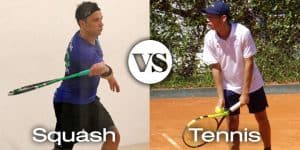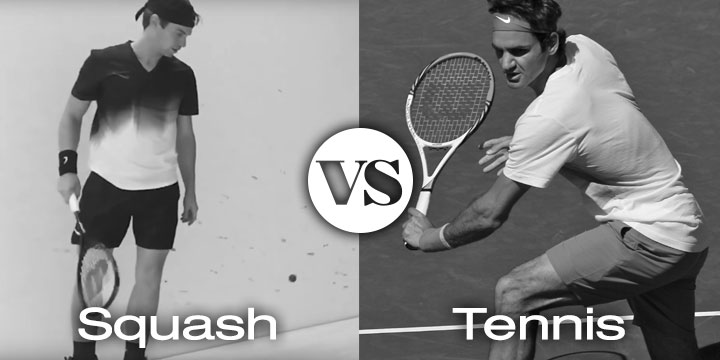[Updated on 1 January 2024] Whether you have played racket sports your whole life or have just gotten started, there is often a time when a passion for one racket sport breeds curiosity for another racket sport. A common crossover combination of racket sports is that of squash and tennis.
Many players play tennis when it is nice outside but then look for something active to do with their racket skills during the winter. Although many clubs offer indoor tennis competition, they tend to be more expensive than ones that offer squash, since squash can be done in less space. Often, squash is an economical way to cross-train for tennis when the weather prohibits outdoor play.

Contents
Squash vs Tennis
Much of the conversation online is a debate of squash vs tennis to determine which sport is better. While we have a definite opinion on this [SQUASH], both sports are fantastic. Speaking personally, I first learned squash but began to play tennis in the summer months. I’ve found that tennis has helped my squash game immensely, and squash has REALLY helped my tennis game. I’ll explain why later.
By playing squash and picking up tennis after, it has led to a great appreciation of watching some of the tennis greats play, those like Roger Federer and Andy Murray who have an appreciation for squash.
https://www.youtube.com/watch?v=m2vQPHkAB-U
While you may need to invest in a new racket, many of the concepts between them will be similar as well as the hand-eye-coordination you have built.
Squash vs Tennis – Key Differences
When you decide to try squash, it may feel quite foreign at first. The racket is different and so are many of the techniques you will use to play the game. Here are some of the other important differences:
- Endurance: Rallies in squash tend to last longer, so you will want to pace yourself, especially when you first get started.
- Court size: The smaller court and surrounding walls can be misleading. Many tennis players think the game will be less work since there will not be the same demand to run across the court. Squash requires endurance in the upper body and the ability to keep going after longer rallies.
- Hitting the wall: As a tennis player, you may be used to hitting long shots down the line. In squash, you will hit shorter shots at the wall.
- Sports balls: Squash balls are significantly bigger and heavier than squash balls. You may find that a solid shot in tennis will result in an out-of-control squash ball.
- Racket differences: While you may not want to invest a lot into squash before you know if you like it, having a squash racket is essential. Not only is it part of legal gameplay, but squash rackets are also often smaller than tennis rackets.
- The rules: As expected, there are significant differences in the rules between the two games. There will be more information below, but you can expect a learning curve as you get used to the rules.
Squash vs Tennis – Swing, Footwork, and Force
Squash requires a more forceful swing than in tennis. For squash, the swing needs to be strong, quick and with follow-through to generate power. Because of a squash ball’s lack of bounce, power and pace are generated in the swing. Contrast that to tennis where a big part of the game is first getting strings on the ball.
Having your racket in “ready-position” is important in squash due to the quicker pace of the game. The transition of your follow-through to the ready position should be quick and seamless. It is an automatic response when it is your turn to track down the ball for a shot.
You’ll want to practice on the squash court by yourself just hitting returns against the front wall as many times as you can, always trying to return the ball directly back to your position. My goal is to hit 40 in a row to land in the same spot on the court. Then I do 40 in a row to hit the same spot on the front wall. This is not an easy drill but is an “80-20” way to get better at squash.
For squash, your footwork is primarily facing the side wall and even backwards when getting ready to hit the ball, vs in tennis your feet are to the side and forward. In squash you need to bend your knees digging balls out of the back corner, one of the toughest shots in squash. Get low with the racquet ready and bring the racquet through, sometimes using the side wall by changing your racket angle to keep the ball in play. Keep your racquet face open, and don’t be worried if you angle it up a bit too high, the front wall is tall enough.
Squash vs Tennis – The Rules of the Game
Tennis matches may go on for a long time because they are made up of six games in a set. In tennis, a player needs to win the best of three sets. In tennis, each game is played to four points.
While in a squash match, the first player to win 3 games wins the match. Squash will have you playing to 11 points.
In both sports, you must win by two points to win a game. Squash games typically last 30 minutes to an hour. Tennis matches usually last at least 75 minutes.
Another difference is the process of serving. In tennis, one player will serve an entire game, and the next player will serve the following game. In squash, the serve changes depending on which player won the last point. If the receiver of the server scores a point, they will become the new server.
Squash vs Tennis – What do I need to play?
Like any sport, for squash, there is a long list of specialized equipment that can help you enhance your game. When you are getting started, these are the essentials:
- Racquet: The squash racket may look similar, but there are important differences in the size and shape that will impact gameplay. Also, if you are going to do more than casual play with your friends, you will need a racket that is legal for squash.
- Balls: Not only do squash balls look different, but the size, shape, and composition of a squash ball are also smaller and lighter than a tennis ball. You will need to pick up a pack of balls when you are ready to give squash a shot.
- Eye protection: It was not something you needed on the tennis court (except maybe in the form of sunglasses), but on the squash court, eye protection is essential. When you are in a small room with a small ball flying in different directions, you need to protect your eyes.
- Shoes: While you may not need specialized squash shoes right away, while you are still trying out the sport, you will need shoes that are clean and will not mark up the court. Many clubs have strict rules regarding clean non-marking shoes and severe consequences (fines or banishment) if you break the rules.
If you are trying squash with a friend, see if they have the equipment you can borrow, such as a spare racket, for your first time trying the sport. You may be able to save the initial investment as well as learn what you do and do not like about what you borrow versus what you would like to purchase.
As you become more dedicated to squash, you will want to invest more into your equipment. You may look at investing in new or upgraded equipment, such as:
- Shoes: One of the first “upgrades” players like to add is squash shoes. While not required for the game, squash shoes offer better support for the specific movements and strains of the game.
- Racket: Whether you have been borrowing one, or you are ready for an upgrade, a new racket can make a significant impact on your game. Try going to a sports store where you can try several rackets or talk to a trainer who will let you hold different models to see what suits you best.
- Squash bag: With all this new equipment, you will need a place to put it. A squash bag can make getting ready for your court time much simpler.
No matter what equipment ends up on your must-have list, there is a variety of price ranges no matter what you are looking for. And, of course, when you are ready to invest more into the sport, there are plenty of options that provide more quality for your investment.
Squash vs Tennis – Is it difficult to change between sports?
Many people either enjoy squash in the winter and tennis in the summer. Some players play both simultaneously. Some players worry that it will take some time to get their swing back. After a good warmup you will be fine (be athletic)!
Some players who are interested in both sports compete in racketlon tournaments. Racketlon is like a triathalon for racket sport athletes. Players change between four different sports (squash, tennis, badminton, table tennis) within one day of tournament play. Players find it is a way to build their endurance and skill in all four events, while still enjoying one or two favorites.
Squash Player in the Winter, Tennis Player in the Summer

Squash vs Tennis – Which Sport is Better?
The easiest answer to which sport is better is that it depends. If you grew up playing tennis and learn squash later, you’ll have a learning curve to get over. If you have the time and patience to learn squash strategy, you will quickly adapt. I’ve found that the swing takes some adjusting, but becomes second nature quickly.
There are aspects of squash that many players find easier, such as the smaller equipment and the smaller play area. On the other hand, others have a difficult time refining their swing to be suitable for a squash court.
No matter what level of tennis player you are, squash can be an excellent way to maintain your fitness during the offseason and refine your skills. You may even find that playing squash will help you fine-tune the elements of your tennis game. Squash can even make you a better player during the tennis season.
- Forum of tennis players playing squash
- Squash player James Willstrop on squash vs tennis
- We put together a resource of squash books to learn more

It is a very helpful game to keep anyone’s body fit from any diseases. I prefer tennis for play regular. But I need some best tennis bat. How to consider what to buy?
The Head Ti6 is a great beginners racquet, while the Wilson Blade (various sizes) or the Babolat Aero Light are great for more advanced players.